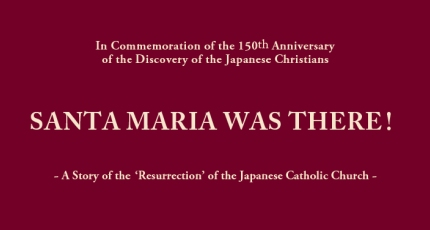Act 1, Scene 1 In Nagasaki, the era of the Edo Shogunate is drawing to a close. For over 200 years, officials have carried out the “Fumie” ritual ordained after Christianity was banned. Shinkichi, one of the Christians who have secretly remained faithful for seven generations, reluctantly treads on the Christian image. Afterwards, he prays in agonized repentance and, as a penance, he drinks the water with which he washed his feet.
Scene 2 Standing before a Maria Kannon statue, Mataichi (a Mizukata or “Baptizer”), one of the few remaining Elders, baptizes baby Yasu Sugimoto.
Scene 3 On the Eve of the Nativity, villagers who have kept the faith gather quietly at Mataichi’s house. They post lookouts and, upon hearing the whistle that tells of approaching officials, they pretend to be drunk and disguise their purpose by dancing. Once the officials are gone, and asking themselves how much longer they will have to behave like this, the villagers comfort one another by recalling both the prophecy of Bastian that the priests will return after seven generations and how their ancestors have kept the faith, never yielding to persecution and martyrdom.
Act 2 In the area of Nagasaki reserved for foreigners after the opening of Japan, Father Petit-Jean of the Parisian Missionary Society is building the Tenshudo (Church). The Nagasaki Magistrate Kawazu-no-kami, in the course of asking him to teach French, makes a point of reminding him that the Japanese ban on Christianity is still in force. In Rome, 26 Japanese martyrs have been canonized, and Father Petit-Jean believes that there are still Hidden Christians who have maintained the faith, and keeps hoping that some of them will appear at the Church.
Act 3, Scene 1 The garden in front of Taju’s house, where they are about to observe the Sabbath. Discussion centers around the French Church (which they call the French Temple) built in Nagasaki. Have the long-awaited priests finally come? The villagers argue whether to risk their lives by going to find out.
Scene 2 Taju’s House. Everyone is gathered for the Sabbath. Yuri the midwife reports what she saw of the French Temple on her way home from work. Wearing black clothes and crucifixes would not necessarily mean they were Catholic priests (Padre). They had been told that Padre must be despatched from Rome, revere Santa Maria, and be celibate. So Yuri is determined to go and check, even if she goes alone, but the men of the village come and oppose her.
Act 4, Scene 1 Yuri Sugimoto’s House. Sure that these at last are the priests for whom they have been waiting, she makes up her mind to go and confirm the truth whatever the opposition. She calls the family together and gives what could be her final farewell.
Scene 2 It is early morning. The women have quietly left their homes and gather together. They set out after Taju and Hachi join them. They split into three groups taking different routes to the French Temple.
Act 5, Scene 1 On the way to the French Temple, the men who opposed them catch up with them. However, the men say that if they cannot dissuade them from continuing, they will join them. The whole group moves off together.
Scene 2 Inside the French Temple, Father Petit-Jean is at prayer, and feels his heart moved by powerful emotion. He hears the sounds of a crowd outside, and when the door is opened, there, at the feet of the statue of Holy Mary, the Japanese Church experiences its moment of “resurrection,” a miracle unprecedented in the Catholic Church throughout the world.



